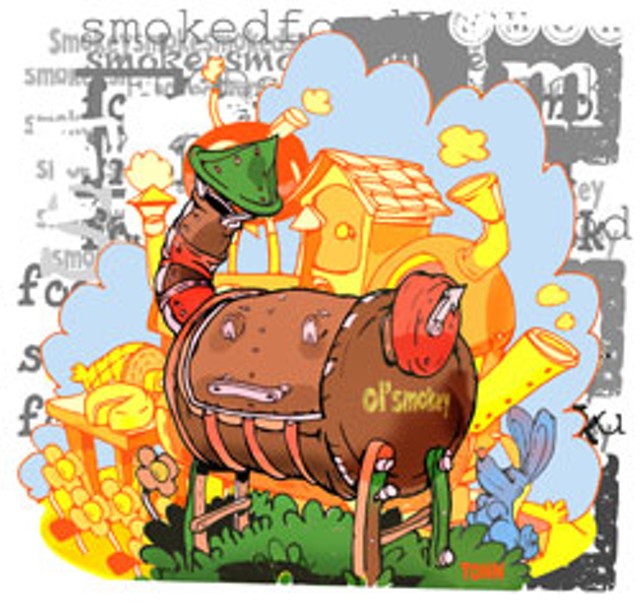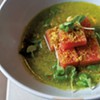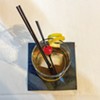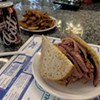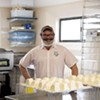Published June 1, 2010 at 3:13 p.m.
For the past month, I’ve been smoking everything in sight. Given decent weather and a few leisure hours, I scour my pantry for foods that might be better seasoned with aromatics from smoldering mesquite or hickory. I’ve tried spears of asparagus — a total bust — crimini mushrooms, lusciously fatty, country-style pork ribs, various cheeses and a juicy, free-range chicken. And wackier things, too: whole raw eggs, a bowl of basmati rice, a banana. Thus far, the smoked marshmallows have been my crowning achievement.
A party was the impetus for my bizarre culinary project. In May, Spencer and Mara Welton of Burlington’s Half Pint Farm hosted a “smoked foods” potluck at their home. Figuring that most people would bring meats or cheeses, I wanted to provide something distinctive. When fellow Seven Days writer Alice Levitt proposed smoked marshmallows, I was sold.
Why smoke at all? Because it’s a fairly simple way to add an additional layer of flavor to food. Pork ribs slathered in barbecue sauce are good: Smoked pork ribs slathered in barbecue sauce are sublime. Given our culture’s current obsession with bacon, which is showing up in everything from chocolate bars to cocktails, it’s no surprise that smoking is in vogue. And when it’s done well, an inexpensive backyard setup can turn out fare just as tasty as what you’d find in the backwoods of Kentucky.
It seems natural to season slabs of meat with the aromatic output from burning wood chips — after all, we’ve been roasting flesh over fires for tens of thousands of years. But giving the same treatment to sweets is nouveau. Nonetheless, it’s not mere gastronomic masturbation. Sugary stuff is often improved by the restrained application of salt, and, likewise, the primal tug of smoky flavor can be surprisingly delightful in dessert.
For a 2001 article in Food & Wine magazine, reporter Anya von Bremzen sampled just such a treat made by a cutting-edge Spanish chef. “As I taste a smoked chocolate mousse,” she writes, “it occurs to me that Elena Arzak is the most exciting woman chef on the planet.” Since then, the New York Times and other popular publications have acknowledged the sweet ’n’ smoky trend.
Marshmallows, porous and simply flavored with vanilla, seemed to me like a perfect candidate for such a treatment. Before I could make ’em, though, I needed a smoker. (While stove-top smoking is possible, it is best done in a kitchen with a ventilation system.) The Internet abounds with blueprints for eager builders: There’s Food Network star Alton Brown’s smoker made from terra-cotta flowerpots, robust versions incorporating old well-washed oil drums and everything in between.
With my DIY scheme making me feel frugal and creative, I headed to Lowe’s for supplies. But once there, I realized that buying an off-the-shelf electric smoker, like the one I was eyeing at $80, was actually cheaper than building one at home. Plus, a hot-plate-style heating element keeps the commercial smoker’s interior at a consistent temperature, making it especially easy for beginners. Smokers that run on charcoal, by contrast, require regular checks and adjustments.
With a cherry-red, bullet-shaped Brinkmann model in tow, I searched the store for accoutrements that would offset some of the smoke — but just a bit of the heat — into another vessel. I wanted to rig up a so-called “cold smoker,” which is used for flavoring delicate items such as cheese, shellfish and marshmallows. To keep such foods from melting or cooking, the interior temperature needs to remain at 90 degrees or less.
Back home, my handy husband and I put together our new appliance. Using copious sheets of aluminum foil and strips of metal tape, we ran a tube from a door in the Brinkmann’s side — used for stoking the vessel with dampened wood chips — into the bottom of our UFO-shaped Weber charcoal grill. The latter would serve, for a time, as a cold smoker.
The day before the potluck, I used recipes from the Smitten Kitchen blog to make a batch of crisp, sweet graham crackers and whip up vanilla marshmallows in my KitchenAid. The gelatin-based confection set overnight in the fridge. In the morning I cut the quivering sheet into rectangular pillows, dusting each one with a coating of confectioners’ sugar. Then I fired up the Brinkmann.
For the first batch of ’mallows, I scattered soaked cinnamon sticks on the lava rocks around the heating element. As they began to smolder, the metal tube between the hot and cold smokers got warm to the touch, and a trickle of aromatic smoke leaked from the top of the grill. Therein, half my marshmallows lolled on a piece of foil. I dropped the probe of a digital thermometer inside so I could manage the temperature, and did my best to keep it below 90 degrees for the next hour.
When they were done, the candies had a pleasantly pronounced cinnamon aroma and a slightly toughened exterior. I decided to repeat the experiment with hickory, thinking the savory quality imparted by the wood would be a boon. Indeed, the second batch of marshmallows was even more tantalizing than the first.
When I arrived fashionably late at the Weltons’, having eaten nothing but graham crackers and marshmallows all day and smelling just as smoky as my dessert, the farmers’ dining-room table was piled with aromatic items. There were tan, tea-smoked scallops perched on pale endive leaves; the Weltons’ home-grown chickens smoked with sage from their garden; and spice-rubbed, smoked potatoes from Abbey Duke, co-owner of Sugarsnap.
After eating several helpings of each — plus some smoked mozzarella and baked beans made with smoked chiles — I constructed my s’mores. The cinnamon marshmallows went on the graham crackers atop squares of dark chocolate, with milk chocolate for the hickory version. A minute under the broiler — to simulate browning over a campfire — and they were ready to go. I placed them on the table beside some decadent smoked-chocolate and whiskey truffles from pastry chef Jen Smith, owner of the Nomadic Oven.
Would it be boastful to say they were a hit? Like Smith’s truffles, the s’mores disappeared rapidly, and both desserts were conversation starters. I left the party dreamily pondering what I would smoke up next.
Flush with success, I got cocky, and some of my next forays were failures. A smoke bath did nothing to benefit a handful of dried apricots or to revive an oldish, arid wedge of provolone from the fridge. On the cheese front, Shelburne Farms’ 2-year-old cheddar and a bloomy-rind Caprella from Does’ Leap Farm were better smoke recipients. The tender baby asparagus, which turned brown and dried out at the tips, proved stringy and inedible.
My efforts were redeemed by a half-dozen Yukon gold potatoes, which worked perfectly in a classic mayonnaise-y potato salad, and a banana, which was pleasantly slippery and fragrant.
After a handful of experiments — often running the hot and cold smokers at the same time with different foods inside — I think I’ve learned a few cardinal rules of smoking. Since the process can impart an acrid flavor, foods that are already bitter may become overwhelmingly so. Fat, by contrast, is a smoker’s best friend. Not surprisingly, items that are desiccated or dense won’t pick up the woody flavor as well as those that are juicy or spongy. Finally, even things that taste good smoked can be oversmoked, and it’s important to serve refreshing, tangy condiments or dishes alongside to refresh your guests’ palates.
I may have some new guidelines, but they won’t keep me from piling my smoker with unusual items in the hopes of producing another delightful surprise like a smoked marshmallow. Next time I plug in the Brinkmann and hear a sizzle as the wood chips begin releasing their fragrance, I may be moved to smoke a bowl of whipping cream or apple sauce, or to play around with lightly boiled and peeled eggs instead of raw ones. When they ripen, tomatoes and peppers will surely end up on the grate. In autumn, perhaps a pumpkin.
They say that smoking can make you a little loopy. I guess I’m living proof.
More By This Author
About the Artist

Michael Tonn
Bio:
Michael Tonn is still just eating gummy bears outside the Shopping Bag in Burlington. To see more of his work and to get in touch, go to michaeltonn.com or @dead_moons on Instagram.
Michael Tonn is still just eating gummy bears outside the Shopping Bag in Burlington. To see more of his work and to get in touch, go to michaeltonn.com or @dead_moons on Instagram.
Speaking of Food
-

Q&A: Howard Fisher Delivers Meals on Wheels With a Side of Good Cheer
Dec 20, 2023 -

Video: Howard Fisher Delivers Meals on Wheels
Dec 14, 2023 -

Q&A: Alexis Dexter Rescued 57 Shelter Cats During the July Flood
Sep 13, 2023 -

Video: Two Months After the Flood, Alexis Dexter Rebuilds Kitty Korner Café in Barre and Continues to Rescue Cats
Sep 7, 2023 -

Video: Saying Goodbye to Burlington’s Penny Cluse Café
Nov 17, 2022 - More »
Comments
Comments are closed.
From 2014-2020, Seven Days allowed readers to comment on all stories posted on our website. While we've appreciated the suggestions and insights, right now Seven Days is prioritizing our core mission — producing high-quality, responsible local journalism — over moderating online debates between readers.
To criticize, correct or praise our reporting, please send us a letter to the editor or send us a tip. We’ll check it out and report the results.
Online comments may return when we have better tech tools for managing them. Thanks for reading.




































